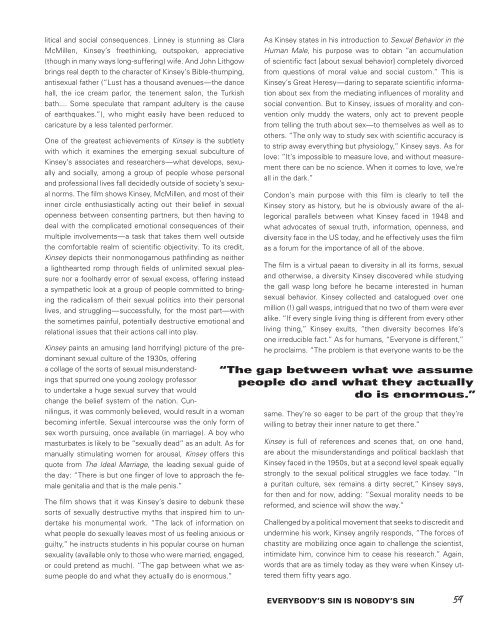Create successful ePaper yourself
Turn your PDF publications into a flip-book with our unique Google optimized e-Paper software.
litical and social consequences. Linney is stunning as Clara<br />
McMillen, Kinsey’s freethinking, outspoken, appreciative<br />
(though in many ways long-suffering) wife. And John Lithgow<br />
brings real depth to the character of Kinsey’s Bible-thumping,<br />
antisexual father (“Lust has a thousand avenues—the dance<br />
hall, the ice cream parlor, the tenement salon, the Turkish<br />
bath.... Some speculate that rampant adultery is the cause<br />
of earthquakes.”), who might easily have been reduced to<br />
caricature by a less talented performer.<br />
One of the greatest achievements of Kinsey is the subtlety<br />
with which it examines the emerging sexual subculture of<br />
Kinsey’s associates and researchers—what develops, sexually<br />
and socially, among a group of people whose personal<br />
and professional lives fall decidedly outside of society’s sexual<br />
norms. The film shows Kinsey, McMillen, and most of their<br />
inner circle enthusiastically acting out their belief in sexual<br />
openness between consenting partners, but then having to<br />
deal with the complicated emotional consequences of their<br />
multiple involvements—a task that takes them well outside<br />
the comfortable realm of scientific objectivity. To its credit,<br />
Kinsey depicts their nonmonogamous pathfinding as neither<br />
a lighthearted romp through fields of unlimited sexual pleasure<br />
nor a foolhardy error of sexual excess, offering instead<br />
a sympathetic look at a group of people committed to bringing<br />
the radicalism of their sexual politics into their personal<br />
lives, and struggling—successfully, for the most part—with<br />
the sometimes painful, potentially destructive emotional and<br />
relational issues that their actions call into play.<br />
Kinsey paints an amusing (and horrifying) picture of the predominant<br />
sexual culture of the 1930s, offering<br />
a collage of the sorts of sexual misunderstandings<br />
that spurred one young zoology professor<br />
to undertake a huge sexual survey that would<br />
change the belief system of the nation. Cunnilingus,<br />
it was commonly believed, would result in a woman<br />
becoming infertile. Sexual intercourse was the only form of<br />
sex worth pursuing, once available (in marriage). A boy who<br />
masturbates is likely to be “sexually dead” as an adult. As for<br />
manually stimulating women for arousal, Kinsey offers this<br />
quote from The Ideal Marriage, the leading sexual guide of<br />
the day: “There is but one finger of love to approach the female<br />
genitalia and that is the male penis.”<br />
The film shows that it was Kinsey’s desire to debunk these<br />
sorts of sexually destructive myths that inspired him to undertake<br />
his monumental work. “The lack of information on<br />
what people do sexually leaves most of us feeling anxious or<br />
guilty,” he instructs students in his popular course on human<br />
sexuality (available only to those who were married, engaged,<br />
or could pretend as much). “The gap between what we assume<br />
people do and what they actually do is enormous.”<br />
As Kinsey states in his introduction to Sexual Behavior in the<br />
Human Male, his purpose was to obtain “an accumulation<br />
of scientific fact [about sexual behavior] completely divorced<br />
from questions of moral value and social custom.” This is<br />
Kinsey’s Great Heresy—daring to separate scientific information<br />
about sex from the mediating influences of morality and<br />
social convention. But to Kinsey, issues of morality and convention<br />
only muddy the waters, only act to prevent people<br />
from telling the truth about sex—to themselves as well as to<br />
others. “The only way to study sex with scientific accuracy is<br />
to strip away everything but physiology,” Kinsey says. As for<br />
love: “It’s impossible to measure love, and without measurement<br />
there can be no science. When it comes to love, we’re<br />
all in the dark.”<br />
Condon’s main purpose with this film is clearly to tell the<br />
Kinsey story as history, but he is obviously aware of the allegorical<br />
parallels between what Kinsey faced in 1948 and<br />
what advocates of sexual truth, information, openness, and<br />
diversity face in the US today, and he effectively uses the film<br />
as a forum for the importance of all of the above.<br />
The film is a virtual paean to diversity in all its forms, sexual<br />
and otherwise, a diversity Kinsey discovered while studying<br />
the gall wasp long before he became interested in human<br />
sexual behavior. Kinsey collected and catalogued over one<br />
million (!) gall wasps, intrigued that no two of them were ever<br />
alike. “If every single living thing is different from every other<br />
living thing,” Kinsey exults, “then diversity becomes life’s<br />
one irreducible fact.” As for humans, “Everyone is different,”<br />
he proclaims. “The problem is that everyone wants to be the<br />
“The gap between what we assume<br />
people do and what they actually<br />
do is enormous.”<br />
same. They’re so eager to be part of the group that they’re<br />
willing to betray their inner nature to get there.”<br />
Kinsey is full of references and scenes that, on one hand,<br />
are about the misunderstandings and political backlash that<br />
Kinsey faced in the 1950s, but at a second level speak equally<br />
strongly to the sexual political struggles we face today. “In<br />
a puritan culture, sex remains a dirty secret,” Kinsey says,<br />
for then and for now, adding: “Sexual morality needs to be<br />
reformed, and science will show the way.”<br />
Challenged by a political movement that seeks to discredit and<br />
undermine his work, Kinsey angrily responds, “The forces of<br />
chastity are mobilizing once again to challenge the scientist,<br />
intimidate him, convince him to cease his research.” Again,<br />
words that are as timely today as they were when Kinsey uttered<br />
them fifty years ago.<br />
EVERYBODY’S SIN IS NOBODY’S SIN 59


